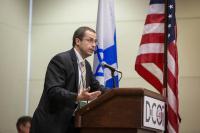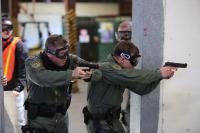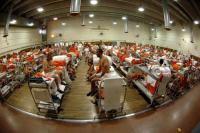-
Tracking, analyzing how ISIS recruits through social media

A team of researchers has developed a model to identify behavioral patterns among serious online groups of ISIS supporters that could provide cyber police and other anti-terror watchdogs a roadmap to their activity and indicators when conditions are ripe for the onset of real-world attacks. The researchers apply the laws of physics to study how terrorist support groups grow online, and how law enforcement can track activities.
-
-
Labor MP killed near Leeds by gunman shouting “Britain First!”

Jo Cox, 41, a Labor MP for Batley and Spen, has been shot and stabbed to death Thursday by a man shouting “Britain First!” She was attacked outside a library in the town of Birstall, West Yorkshire. Cox has been campaigning for the United Kingdom to stay in the EU – the referendum on this question is to be held Thursday, 23 June. Britain First, founded in 2011, is a far-right political party campaigning against immigration, multiculturalism, and what it sees as the Islamization of Britain. Members of Britain First conduct what they call “Christian patrols” outside of mosques and the homes of Muslim leaders.
-
-
The Orlando shooting: exploring the link between hate crimes and terrorism

Some are calling the mass shooting at an Orlando gay nightclub an act of terrorism. Others are calling it a hate crime against the LGBT community. President Obama declared it an “act of terror and an act of hate.” Can it be both? The Orlando tragedy demonstrates the importance of exploring difficult questions. For example, are terrorists who commit acts of hate and terrorists who target the government radicalized the same way? Are perpetrators motivated by far-right extremist views similar to those motivated by jihadist extremism? What factors helped push these perpetrators to violence, and what steps can be taken to stop it from occurring again? Answering these questions may help law enforcement identify, investigate, prosecute, and ideally thwart those who seek to turn to violence to achieve their goals.
-
-
AR-15: The most popular assault-style rifle in the United States
The gunman who killed dozens of people in Aurora, Sandy Hook, San Bernardino, and, yesterday, Orlando all used an AR-15 rifle. According to the National Rifle Association (NRA), the gun, which was designed by ArmaLite for the U.S. Army and originally produced by Colt in the 1960s, is the most popular rifle in the United States. Between 5 and 8.2 million assault-style rifles are privately owned by U.S. citizens, and 3.3 million of those were AR-15.
-
-
Major mass-shooting attacks in the U.S. since January 2009

Between 2008 and 2013, the FBI used a narrow definition of mass shootings – limiting the designation “mass shootings” to incidents in which an individual “kills four or more people in a single incident… typically in a single location.” In 2013 the FBI changed its definition, moving away from “mass shootings” to identifying an “active shooter” as “an individual actively engaged in killing or attempting to kill people in a confined and populated area.” The FBI designated the incidents listed below as mass-shooting incidents.
-
-
Six things Americans should know about mass shootings

The United States had 78 mass shootings during that 30-year period. The highest number of mass shootings experienced outside the United States was in Germany – where seven shootings occurred. In the other twenty-four industrialized countries taken together, 41 mass shootings took place. In other words, the United States had nearly double the number of mass shootings than all other twenty-four industrialized countries combined in the same 30-year period.
-
-
Offender risk assessment tools in U.S. are promising, but questions remain
The criminal justice system in the United States uses a variety of tools to assess the behavior of criminal offenders, and those risk assessments can have a significant impact on an offender’s fate. A new meta-analysis of the research conducted in the United States on these tools shows that – while promising – it is still unclear whether these tools reduce bias against offenders based on race or other factors.
-
-
Revisiting the relationship between hate crime and terrorism
New research from START examines the link between hate crime (bias-motivated crime) and terrorism at the county level, focusing on far-right extremism in the United States and pulling data from the U.S. Extremist Crime Database (ECDB) and the Global Terrorism Database (GTD). Among other things, the research has found that counties experiencing increases in one type of bias-motivated or extremist violence are likely to see significant increases in other types of extremist activity.
-
-
Europe-wide ballistic information sharing would reduce gun death from terrorism, crime
All countries across Europe are being urged to establish national “Firearms Focal Points” to collect, study, and share information about firearms and ballistics to help reduce the number of deaths and injuries caused by gun crime and terrorism. This is one of the key findings following a 15-month multi-agency research project which looked to analyze the prevalence of gun crime across Europe and, based on the findings, identify initiatives and interventions that could be further pursued and developed to tackle the problem.
-
-
Active shooter exercise evaluates tactics, technologies

The New York Police Department (NYPD), the Fire Department of New York (FDNY), and the Department of Homeland Security (DHS) Science and Technology Directorate (S&T) took part in an active shooter exercise early Sunday at a Brooklyn high school to evaluate tactics and technologies for responding to and containing rapidly escalating shooting incidents.
-
-
Prison population can be reduced substantially without endangering public safety: Study

A new study addresses one of the most important crime policy questions in America: Can prison populations be reduced without endangering the public? The studytested the impact on public safety of California’s dramatic efforts to comply with court-mandated targets to reduce prison overcrowding. The results showed that California’s Realignment Act, passed in 2011, had no effect on aggregate violent or property crime rates in 2012, 2013, or 2014.
-
-
U.S. police departments can clear more homicides
Only about 65 percent of homicides in the United States are solved — down 15 percent from the mid-1970s — but a new examines how some police departments are getting it right. Bottom line: There is no silver bullet to reversing the steady decline in the homicide clearance rate.
-
-
Calif. Muslim woman sues Long Beach police for forcibly removing her headscarf
Kirsty Powell, an African American Muslim woman, has on Monday sued the police in California, charging that her headscarf, which she was wearing for religious reasons, was forcibly removed by officers after she was arrested on outstanding warrants. The suit states that Powell “suffered and continues to suffer extreme shame, humiliation, mental anguish and emotional distress” as a result of her experience at the police station.
-
-
EU should establish U.S.-style intelligence agency: EU president
The terrorist attacks in Paris and Brussels, just as the earlier ones in Madrid (2004) and London (2005), were a reminder that central pillars of the EU, such as the “area of freedom, security, and justice,” are being challenged. Jean-Claude Juncker, president of the European Commission — the executive branch of the European Union (EU) – said that the EU member states’ mindsets and willingness to cooperate – crucial ingredients in the fight against terror – have not lived up to the challenge. The enduring lack of coordination between security services, police, and judicial authorities, at the national and the European levels, needs to be urgently tackled to reduce Europe’s vulnerability to such risks. To address and resolve these problems, and bolster European security in the face of terrorism, Juncker has proposed a European “Security Union.”
-
-
New Yorker sentenced to 16 years for trying to buy ricin
It was a scary scenario: Chinese national Cheng Le, living in New York City, attempted to order ricin through the so-called dark Web. Ricin is a highly potent and potentially fatal toxin with no known antidote. What did Le plan to do with the ricin? Nothing good. According to U.S. Attorney for the Southern District of New York Preet Bharara, “In Le’s own words, established at trial, he was looking for ‘simple and easy death pills’ and ways to commit ‘100 percent risk-free’ murder.”
-
More headlines
The long view
How Male Grievance Fuels Radicalization and Extremist Violence
Social extremism is evolving in reach and form. While traditional racial supremacy ideologies remain, contemporary movements are now often fueled by something more personal and emotionally resonant: male grievance.
